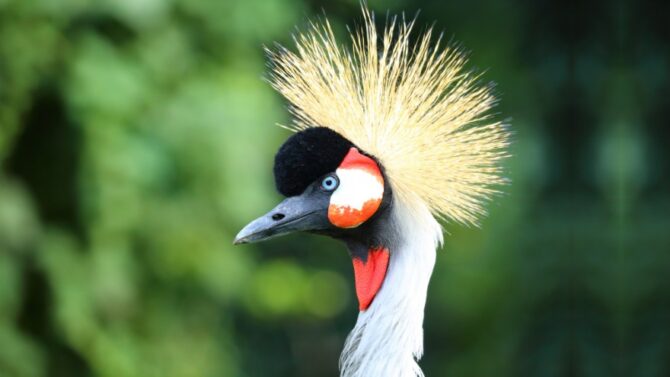Africa’s tropical deserts, equatorial rainforests, and savannah grasslands constitute an array of diverse ecosystems, housing many of the world’s most famous fauna, including giraffes, zebras, and cheetahs.
The tropical continent hosts various species, some of which are endemic to certain parts of the continents.
While you are familiar with the “Big Five,” lion, leopard, elephant, rhinoceros, and buffalo, scientists explore Africa’s jungles, forests, grasslands, and deserts for unique species like the hirola, mountain bongo, hartebeest, and civet, among others.
These animals are uncommon, and there might be many more you have never heard of or thought existed in the wildlife in Africa.
Do you know the most dangerous or endangered animals on the continent? What about fishes and birds you can find in Africa? Read on to discover African wildlife.
Wildlife in Africa: Top Native Animals in Africa
Africa is home to about a thousand mammal species. These species reside in game reserves, national parks, and other wildlife centers for tourism and conservation purposes.
However, only a few of these species attract tourists from all over the globe.
The “Big Five” mentioned earlier are amongst the continent’s top wildlife, but there are more, which the following paragraphs will discuss.
Lion
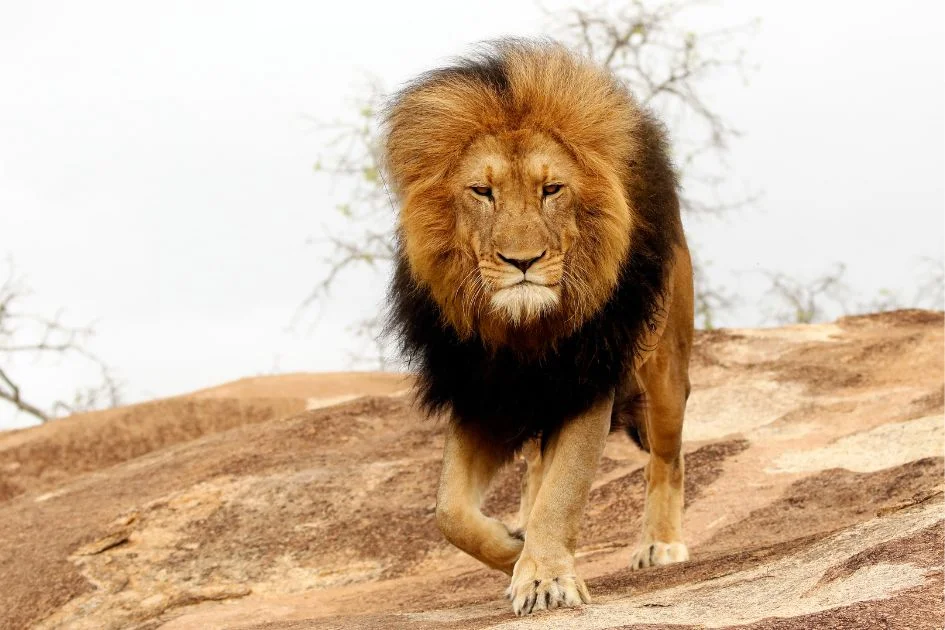
Scientists name: Panthera Leo
Lions are native to Africa and are apex predators in their natural ecosystems in scrublands, savannahs, and grasslands; little wonder many cultures within the continent depict the animal in literature, paintings, sculptures, flags, and other arts.
While lions prefer grassy plains, bordering rivers, savannahs, and open woodlands with bushes. Savannahs with 300 to 1,500 mm annual rainfall constitute most African lion habitats.
Some populations also reside in West African tropical moist forests and East African montane forests. Sadly, Africa’s lion population has declined substantially, dropping 50% in only twenty years.1
Nevertheless, you will find lions in the Kgalagadi Transfrontier Park and Serengeti National Park.
Leopard
Scientific name: Panthera pardus
The spotted wild cat resides across sub-Saharan Africa, native to many African countries. African leopards inhabit the Cape Provinces of South Africa, Somalia, Ethiopia, and West Africa, relishing their mountainous forests, grasslands, and savannahs.
Leopards, one of Africa’s “Big Five” wildlife, attract many tourists; Zambia’s South Luangwa National Park and South Africa’s Sabi Sands Game Reserve are some of the most prominent leopard centers in the continent.
The Virunga has recorded leopard sightings as the animals drink the park’s thermal waters.
Elephant
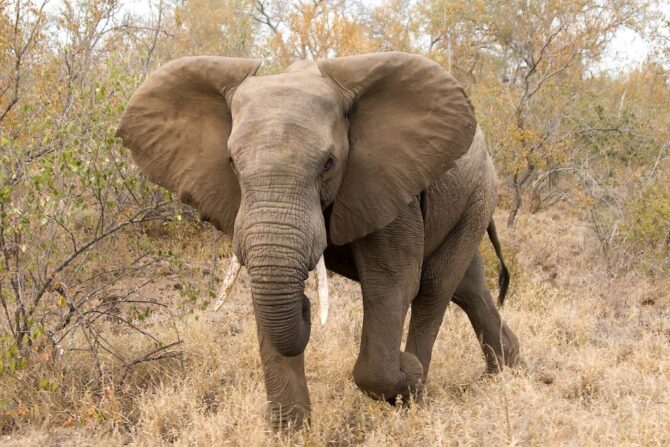
Scientific name: Elephas africana
African elephants are considered endangered by the IUCN; however, they are native to the continent, inhabiting the Sub-Saharan arid regions and Sahelian scrub.
They also reside in tropical rainforests, mopane, and miombo woodlands but primarily have populations in Central Africa.
The African elephant’s native occupancy in the continent explains why many cultures revere it as a symbol representing strength and power.
Rhinoceros
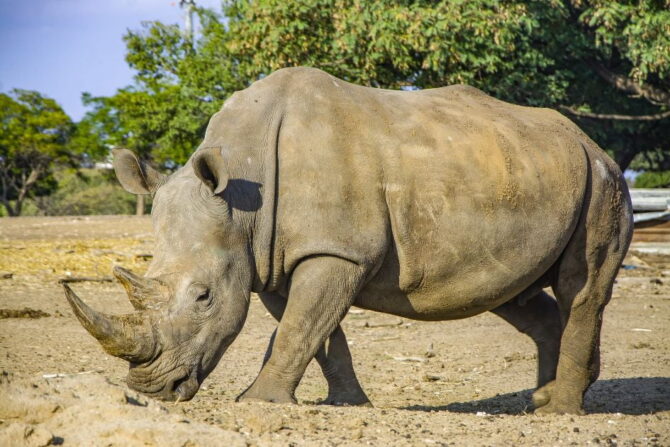
Scientific name: rhinoceros
The black rhino specie is endemic to Africa, occupying the eastern and southern regions.
While populations inhabited eleven countries, most wild rhinos today, from the estimated six thousand, reside in only four countries, Zimbabwe, South Africa, Namibia, and Kenya, roaming the open savannahs and grasslands.2
Black rhinos grow up to 5.2 feet, weighing 1,760 to 3,080 pounds.
Buffalo
Scientific name: Syncerus caffer
Buffalos might have a large population in South Dakota, but the African buffalo occupy every part of the continent.
One subspecies, the Cape buffalo, inhabits Southern and East Africa, while the other, the forest buffalo, inhabits Central and West Africa.
These species are enormous, reaching up to 5.6 feet in shoulder height and weighing up to 1,900 pounds.
While you may not find buffalos roaming around scanty bushes, they live in swamps, savannahs, mopane grasslands, floodplains, and other habitats with dense cover.
Remarkably, Buffalos are usually on the high end of their ecological food chain, with few predators and reliable defensive mechanisms and skills.
Endemic African Animals
Some species are ecologically distributed in specific locations. While several animal species live in Africa, some of these animals can only be traced to areas in which they originated. We will now consider some African endemic animal species.
Hirola
Scientific name: Beatragus hunteri
Conservation status: Critically Endangered (Population decreasing)
The hirola, the world’s rarest antelope, is endemic to northeast Kenya and southwest Somalia. One can easily identify the antelope by its white spectacles around its eyes, a white tail that extends to the hocks, and sharp, lyre-shaped horns.
The hirola inhabits arid environments with annual rainfall averaging twelve to twenty-four inches. While it is a habitual grazer, favoring grasses with more leaves than the stem, it may browse during the dry season.
Sadly, there are between three hundred and five hundred hirola in the wild; the hirola is notorious for a historic decline due to overhunting, habitat loss, severe drought, and predation.3
The Mountain Bongo
Scientific name: Tragelaphus eurycerus isaaci
Conservation status: Critically Endangered (Population decreasing)
It might surprise you that zebras are not the only mammals with distinctive stripes. The mountain bongo, an antelope endemic to African dense forest mosaics, has white-yellow stripes and black-and-white markings on their reddish-brown coat.
The mountain bongo is one of the two bongo subspecies; sadly, fewer individuals in the wild than in captivity, with an estimated 100 mountain bongos remaining in the wild.
Bongos exist in tropical jungles with dense undergrowth around Central and West Africa.
However, the mountain bongo, also known as the eastern bongo, inhabits the forest mosaics with fresh, low-level vegetation in East Africa.
African civet
Scientific name: Civettictis civetta
Conservation status: Least Concern
The African civet is a nocturnal, solitary mammal that enjoys small vertebrates, eggs, invertebrates, and vegetable matter. Unlike the mountain bongo and hirola, the African civet currently faces little threat to its existence.
However, it is endemic to Africa, inhabiting its savannahs and forests. One can find an African civet in most parts of the continent except the north.
Hartebeest
Scientific name: Alcelaphus buselaphus
Conservation status: Least Concern
The hartebeest is another antelope species endemic to Africa; it is a large-sized animal with a conspicuous hump over the shoulders, a large chest, and a long face that differentiates it from other antelopes.
While hartebeests are grazers, with grasses comprising most of their diet, you may not find them in rainforests or areas with dense vegetation.
Hartebeests prefer dry savannas, wooded grasslands, and open plains in West, Central, South, and southeast Africa; they often move to more arid places after rainfall.
The Most Dangerous Animals in Africa
While many African species attract tourists, some are not so friendly and could be deadly if they feel threatened.
Lions, rhinos, buffalos, mosquitos, and elephants are among the dangerous wildlife in Africa, but there are more. Here are other dangerous animals on the black continent.
Nile Crocodile

Scientific name: Crocodylus niloticus
Nile crocodiles have earned a ferocious status all over Africa. Their beady eyes and snappy jaws have terrified millions in the continent, from Egypt, Central, and East Africa down to South Africa.
These crocodiles are aggressive, strong, and fearless, with a 22,000 Newton bite force. They inhabit the Nile Basin, sub-Saharan Africa, the Madagascan rivers, mangrove swamps, and freshwater marshes.
Reports show that Nile crocodiles were responsible for no fewer than 480 attacks on Africans and 123 fatalities between 2010 and 2014.4
Hippopotamus

Scientific name: Hippopotamus amphibius
While hippos seem round and cute, these water horses are far from gentle and docile. The hippopotamus has an ugly history with humans and has not been nice to other animals.
Thus, the hippopotamus has earned a reputation for being the world’s deadliest land mammal, killing an estimated 500 people annually in Africa.5
You would not dare a hippo; at up to 2,750kg, it can crush a human to death. Still, its tusk, speed, and nature to suddenly attack without warning are other terrifying cues to consider before subconsciously admiring one.
You may not find hippos everywhere in Africa but in Central, Eastern, and Southern Africa.
Great White Shark
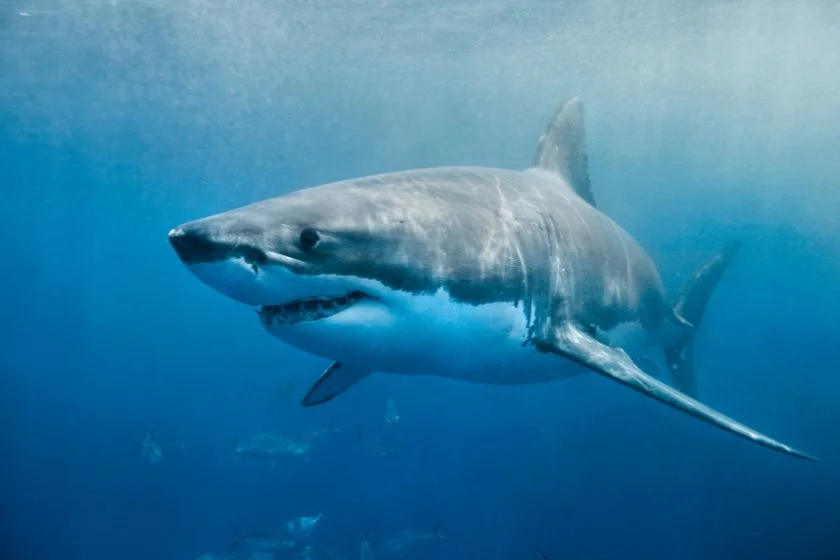
Scientific name: Carcharodon carcharias
Gansbaai, a town in South Africa, is the only place where you can find great white sharks every time of the year, such that it bears the title “Great White Capital of the world.”
This shark inhabits parts of South Africa’s oceans, eating earless seals, rays, and sea lions. The apex predator stops at nothing to prove its position in the food chain, attacking humans it considers intruding.
The great white shark is responsible for about thirty-three to fifty of 100-plus annual shark attacks worldwide, and victims are liable to die from blood loss.
Puff Adder
Scientific name: Bitis arietans
The African savannah and grasslands are home to the puff adder; the Sahara and rainforest regions are the only places in the continent where finding a puff adder might not be possible.
The three-foot venomous viper specie earns a fearsome reputation for its large proportion of venomous snakebites in sub-Saharan Africa, inflicting its victims with low blood pressure, tissue necrosis, and spontaneous bleeding.6
Black Mamba
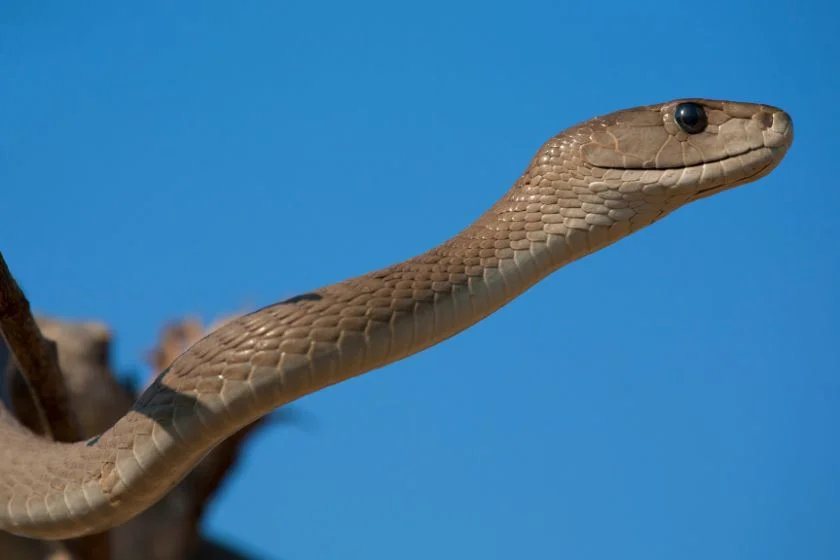
Scientific name: Dendroaspis polylepis
The puff adder is not the only venomous snake in Africa; in all but name, the black mamba is notoriously deadlier, such that African myths exaggerate their reputations to legendary proportions.
An adult black mamba has between 12 and 20 drops of venom per fang, whereas only two drops are lethal to an adult human.
The average adult black mamba is between 6.6 and 8.2 feet long; however, you may find one around fourteen feet.
What many revere as the world’s deadliest snake inhabit South and East African savannahs, its open woodlands, and rocky hills.
They live in the continent’s tropical and temperate regions, occupying burrows, empty termite mounds, rock crevices, hollow trees, and low, open spaces.
Endangered African Animals
Africa houses many species, but not all have a healthy breeding population. While some thrive and record a viral population increase, others may fade into extinction in the next few decades.
The African penguin and black rhino are two endangered species; here are some of the rest.
Rothschild’s Giraffe
Scientific name: Giraffa camelopardalis rothschildi
Conservation status: Endangered (Population decreasing)
The Rothschild’s giraffe is among the nine giraffe subspecies in the world; however, it is endangered, with 1,669 mature individuals estimated in the wild in 2016.
You can tell the Rothschild’s giraffe apart from the other subspecies because they have no markings on their lower legs.
While their population is steadily declining, you can find them in Uganda and Kenya, with implementations in place to save them from extinction in the latter.7
Grévy’s Zebra
Scientific name: Equus grevyi
Conservation status: Endangered (Population stable)
It is sad to see the largest extant wild equid become the most threatened of the three zebra species. However, we hope they may survive extinction with a stable population, thanks to the semi-arid savannahs of Kenya, Somalia, and Ethiopia.
While all zebras have exclusive black and white stripes, the Grévy’s zebra has a mule-like appearance that differentiates it from the other species’ horse-like appearance.
This zebra feeds on legumes and grasses, with a wonderful ability to survive up to five days without water.
African Wild Dog
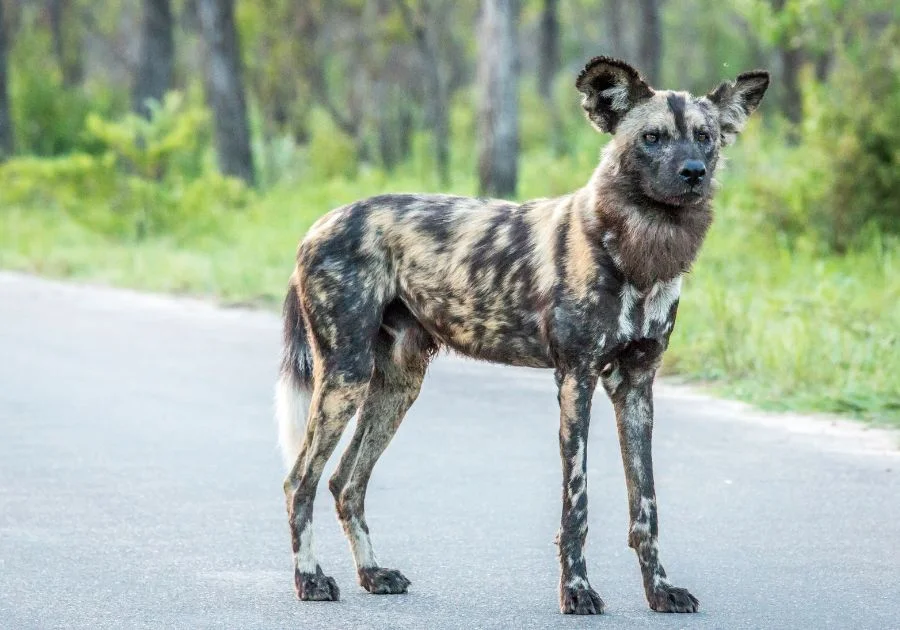
Scientific name: Lycaon pictus
Conservation status: Endangered (Population decreasing)
The African wild dog might not be easy on the eye, but it is among sub-Saharan Africa’s native species and the largest wild African canine.
It differs from other wild dog species via its hypercarnivorous dentition and lack of dewclaws. The African wild dog generally avoids forested areas, inhabiting savannahs and arid zones.
Still, habitat fragmentation and human persecution, and diseases threaten wild dog subpopulations in Africa. Zimbabwe, Botswana, and Namibia now host most of the species’ population.
Grey Crowned Crane
Scientific name: Balearica regulorum
Conservation status: Endangered (Population decreasing)
This bird is one of several names, including the African crowned crane, East African crane, and East African crowned crane. While the most favored seems like the grey-crowned crane, other names suggest it is endemic to Africa.
While the grey-crowned crane is similar to other cranes’ size, measuring 6.5 feet in wingspan length, it differs from the rest with a crown of stiff golden feathers and a relatively short and grey bill that matches the feather color on its body.
The grey-crowned cranes do not have established migration patterns. Still, you can find them in Sub-Saharan Africa’s dry savannahs, marshes, and grassy flatlands near lakes and rivers in Kenya, Uganda, and South Africa.
Okapi
Scientific name: Okapia johnstoni
Conservation status: Endangered (Population decreasing)
Sighting an okapi’s posterior from behind may cause you to mistake it for a zebra; however, it is more related to the giraffe as the only extant member of the Giraffidae family.
It is best if you are not quick to assume that the okapi is as tall as a giraffe, as it is only four feet, eleven inches. This animal resides in canopy forests but is essentially solitary.
Thus, habitat loss due to logging, human settlement, and hunting contributes to the declining population of okapi. Okapi populations still reside in the wild in the Ituri Rainforest, Democratic Republic of Congo.
Birds in Africa
Africa’s bird sphere is diverse, with its avifauna including 2,477 bird species and 1,400 species endemic to it. Here are some birds exclusive to the continent.
Hornbills
Scientific name: Bucerotidae
Believed to signify good fortune, Africa is home to 23 of 54 hornbill species. The Southern ground hornbill, for instance, is the largest species in the southern part of Africa (Angola, South Africa, Kenya), While Senegal, the Gambia, southern Mauritania, and western Mali are home to the Red-billed Hornbill’s western variant.
Hornbills are diurnal (active during the day); frequently, they would get up with the sun to groom and call their neighbors before going to eat, sometimes in small groups or pairs.
This tropical bird can be spotted by their extensive, curved bills, on which some have a sizable casque, from which they get their names.
Due to their splendor and elegance, many people have assumed that the Hornbill is a herbivore, yet surprisingly, this bird is an omnivore. Various tiny insects and even birds are included in its meal plan.
Two hornbill species are carnivores, the Abyssinian or northern hornbills of Africa and the southern ground hornbills; they are distinct because of their predatory nature and time spent on the ground.
African Penguins
Scientific Name: Spheniscus demersus
Africa’s southwest coast and islands are home to the African penguin. The beautiful pink skin spots above its eyelids identify this bird.
However, these spots control the bird’s body temperature as blood is delivered to these patches when the penguins become too warm; ambient air cools the blood and gives the glands a pink appearance.
The International Union for Conservation of Nature (IUCN) now lists the African penguin as Endangered due to its dwindling population. Experts believe African penguins may go extinct in the next few decades, with only 10,000 breeding pairs left in South Africa.8
African Penguins are very social birds; these species are also monogamous as they stick to one partner and can form lasting bonds. They are active at dawn and dusk and eat pieces (piscivores).
Pilchards, round herrings, anchovies, horse mackerel, crabs, squid, and other shoaling pelagic species make up most of their diet.
African penguins spend extended periods fishing at sea, and depending on the region; they can go up to 110 kilometers in a single excursion.
Common Ostrich
Scientific Name: Struthio Camelus
Known as the world’s largest bird, the common ostrich inhabits the African savannahs in east Africa (Tanzania) and some Southern and Northern parts of Africa.
Its pink skin(peculiar to the male), long neck, and strong, sturdy legs can not be missed; by any chance you miss those, its deep booming calls, heard from a great distance, will capture your attention.
The ostrich makes up for its lack of flight with speed, running a distance of 31 miles per hour and sprinting for up to 43 miles per hour.
Although an ostrich prefers to eat plants, it will consume other foods if necessary. Ostriches consume a lot of water—about 10 liters per day—especially young ones.
Secretary bird
Scientific Name: Sagittarius serpentarius
The secretary bird has feather crests at the back of its head that mimic 18th-century clerks with pens tucked into their wigs, from which it gets its name.
It is a diurnal carnivore, foraging for mice, hares, snakes, insects, and other birds’ eggs during the day. It breaks in the shade of trees during the warmest parts of the day and returns to its roost before dusk.
The secretary bird inhabits south of the Sahara Desert, from Senegal to South Africa and east to Somalia, gracing these locations with exciting courtship displays.
Secretary birds chase themselves with their wings stretched up and backward, similar to their hunting movement.
Guinea Fowl
Scientific Name: Numididae
Various Guinea fowl species inhabit the Sub-Saharan deserts, including the plumed Guinea fowl in west-central Africa and the vulturine guineafowl in northeast Africa.
There are seven Guinea fowl species, but all are social and active birds that wander in groups. They can easily withstand hot and more arid environments, even though they have enjoyed years of domestication like the chicken.
Guinea Fowls are omnivores, eating seeds, roots, sedge tuber, and insects. While the Guinea fowl can fly, it prefers walking, except it is fleeing away from danger or predators.
Shoebill
Scientific Name: Balaeniceps rex
The shoebill gets its name from its foot-long bill, which resembles a Dutch clog. According to estimates, approximately 3,300 to 5,300 mature shoebill breeds remain in the wild, and populations inhabit Africa’s freshwater wetlands, from South Sudan to Zambia.
Shoebills are non-migratory, monogamous birds that can remain motionless for hours; this pays off when it’s time to eat, as it enables them to ambush unaware prey who probably had no idea the motionless bird was lying nearby.
Once prey is in the bird’s sights, it strikes rapidly, with its sharp beak ending in a kill. Fishing takes up most of the day for shoebills in waters with less oxygen, where fish must surface more frequently.
Snakes in Africa
Africa is home to several venomous and non-venomous snake species, hosting them in every type of habitat, including tropical, desert, and aquatic habitats.
We previously considered the puff adder and black manga, some of the continent’s deadliest animals, but we will now consider some snakes native to Africa.
Boomslang
Scientific name: Dispholidus typus
The boomslang, one of the world’s most venomous snakes, is native to sub-Saharan Africa’s savannahs.
While the boomslang does not attack humans as it feeds on chameleons, frogs, small mammals, birds, and eggs, its bite is deadly, with a hemotoxic venom that causes hemorrhage in tissues.
However, you may find the snake in forested areas, lowland forests, and grasslands, thanks to its excellent climbing skills and highly arboreal nature.
Bush Viper
Scientific name: Atheris
Seventeen bush viper species are endemic to tropical sub-Saharan Africa, except Southern Africa, due to their strictly arboreal nature.
These snakes with broad, triangular heads distinct from their necks with broad, triangular heads distinct from their necks reside in rainforest regions and forests in West and Central Africa.
They have overlapping, strongly-keeled dorsal scales, ta, and tails that can support the body while suspended from tree branches.
Cape Cobra
Scientific name: Naja nivea
The cape or yellow cobra is a highly venomous species inhabiting bushveld, arid savannas, fynbos, desert, and semi-deserts around the region.
While the Cape cobra has a smaller geographical range than other African cobra species, it occurs in various habitats in Southern Africa. The cape cobra is a terrestrial snake but readily adapts to arboreal life if needed.
It feeds on rodents, birds, lizards, and other snakes; it is generally calm to humans compared to other African venomous snakes but will unhesitantly strike if threatened.
Like other cobra species, the cape cobra transmits a very potent and fast-acting neurotoxic venom that must be considered life-threatening and requires urgent medical care.
Ball Python

Scientific name: Python regius
Ball pythons fall amongst one of Africa’s non-venomous snakes, endemic to West and Central Africa, inhabiting its shrublands, grasslands, and open forests.
However, it is the continent’s smallest python, growing no more than six feet, with a reputation for folding into a ball when distressed or frightened.
Ball pythons eat small birds, mammals, and rodents, constricting them as they have no venom to render their prey defenseless. These pythons reside on the West coast of Senegal, Ghana, Côte D’Ivoire, Sudan, Chad, Cameroon, and Uganda.
Brown House Snake
Scientific name: Boaedon capensis
Sighting the brown house snake might send you scampering for safety because of its scary appearance, but it could do no more than that.
It is a myth that Africa does not contribute to the exotic pet trade as the brown house snake is increasing in global popularity.
The snake inhabits grasslands and areas scattered with shrubs and trees around Mozambique, Zambia, Botswana, South Africa, and Zimbabwe, nocturnally hunting rodents, lizards, and nestlings.
African Rock Python
Scientific name: Python sebae
The African rock python is the continent’s largest snake and one of the world’s largest. How large? An African rock python may grow up to sixteen feet, five inches, with some reaching or exceeding twenty feet.
Despite their size, these snakes inhabit various habitats, from forests, savannahs, grasslands, rocky areas, and semi-deserts, but usually near water sources like swamps, rivers, and lakes.
They are apex predators in their habitats, feeding on antelopes, monkeys, goats, waterfowls, and crocodiles. Countries in sub-Saharan Africa, West, Central, East, and Southern Africa are home to the African rock python.
Fish in Africa
The Nile, Orange, Zambezi, Victoria, and other popular African rivers and lakes are home to various freshwater fish species.
The Indian and the Atlantic Ocean surrounding the continent also houses thousands of marine fish species. Here are some of Africa’s aquatic wildlife.
Tuna
Scientific name: Thunnini
The Atlantic Ocean and the Mediterranean Sea surrounding Africa are home to tunas, typically found in temperate and subtropical waters.
They reside close to the coast and offshore, with some being found in relatively deep waters, depending on the species; there are fifteen. Tuna are carnivores, feeding on fish and squid.
Sharks
Scientific name: Selachimorpha
Some unique shark species only occur in Africa’s waters, especially South Africa, consuming other sharks, marine mammals, fish, crabs, and mollusks.9
Sharks inhabit the continent’s tropical waters to South Africa’s kelp forests along the southwest coast. Fortunately, not all that species attack humans.
Mackerel
Scientific name: Scomber scombrus
Mackerel live primarily on the coast or offshore in the temperate and tropical waters of the northern part of the Atlantic Ocean.
Mackerels have an extremely streamlined design and have blue or silver skin with dark blue markings.
Their diet consists of shrimp, sand eels, and young fish. And this fish species’ population has lately expanded to 57 million, and their twenty-year lifespan is a crucial factor in their population success.
Black Marlin
Scientific name: Istiompax indica
The black marlin, the largest marlin species, inhabits South African waters, populating the KwaZulu-Natal coast during summer.
They feed on squids, octopuses, and fish by slashing their long bill back and forth to catch and stun prey. Black marlins can weigh more than 1,500 pounds, reaching sixteen feet.
Barracuda
Scientific name: Sphyraena
The barracuda is intimidating, with long teeth resembling knives, a huge mouth, and thick scales. Its body is lengthened, somewhat compressed, and coated in minuscule, slick scales. Its diet includes mullet, jacks, grunts, herrings, and snappers.
The Atlantic, Pacific, and Indian oceans are home to the barracuda. They can be found globally in tropical and subtropical waters.
African longfin eel
Scientific name: Anguilla mossambica
The African longfin eel is among the eight hundred eel species in the world, inhabiting the freshwaters of southern Kenya, Madagascar, and Cape Agulhas.
This eel can reach 4′ 11″ and live for about 20 years, sustaining itself on carcasses, crabs, and bony fish. While the African longfin eel’s existence is not vulnerable or close to extinction, it is not of the least concern.
Threats to eels include overfishing, pollution, and environmental changes. Dams and other causes threaten eel habitat and migration routes.
Manta Rays
Scientific name: Manta
The enormous manta ray can be found worldwide in tropical, subtropical, and temperate bodies of water. It frequently inhabits offshore, oceanic, and productive coastal regions.
Manta rays can be identified by their vast, diamond-shaped bodies, which have elongated pectoral fins that resemble wings, ventral gill slits, lateral eyes, and broad, terminal mouths.
There are two species of Manta Rays: Reef manta rays (Manta alfredi) and giant manta rays (Manta birostris), both species often spotted in South Africa.
They predominantly consume shrimps, crabs, copepods, mysids, and euphausiids. Bycatch and overfishing are major threats to the species as the demand for manta gills has increased.
Places to Watch Wildlife in Africa
One might be motivated to visit Africa after reading about the continent’s exotic array of wild animals. However, these animals do not roam around the streets and try to avoid human interaction.
Let us now consider some incredible destinations where you are sure to enjoy extraordinary sights worthy of your bucket list.
- Chobe National Park, Botswana
- Central Kalahari Game Reserve, Botswana
- Lake Nakuru National Park, Kenya
- Maasai Mara National Reserve, Kenya
- Solio Game Reserve, Kenya
- Etosha National Park, Namibia
- Volcanoes National Park, Rwanda
- Kruger National Park, South Africa
- Sabi Sands Game Reserve, South Africa
- Ruaha National Park, Tanzania
- Ngorongoro Crater, Tanzania
- Bwindi Impenetrable Forest, Uganda
- Lower Zambezi National Park, Zambia
- Hwange National Park, Zimbabwe
Frequently Asked Questions
What kind of wildlife does Africa have?
Africa houses many of the world’s most popular wildlife, including lions, leopards, elephants, cheetahs, buffalos, hippos, zebras, and antelopes.
What habitats in Africa support wildlife?
Tropical rainforests, wooded grasslands, deserts, semi-deserts, and plains in Africa have the perfect climate and terrains to support specific wildlife.
What African country has the most wildlife?
One can find wildlife in most parts of Africa, but Tanzania has the continent’s largest wildlife population, with an estimated four million animals.
Which wild animal kills the most humans in Africa?
Most African wild animals have no business with humans and avoid interaction with urban areas. However, some animals will not fail to see humans as threats if they come too close to their territories. The hippopotamus has earned a reputation for being the world’s deadliest land mammal, killing an estimated 500 people annually in Africa.
What is the strongest animal in Africa?
Lions, Nile crocodiles, buffalos, and hippos are among Africa’s strongest animals; nevertheless, none can defeat an adult African elephant, the world’s strongest land animal, by brute force.
Wrap Up
Africa’s picturesque sights and breathtaking adventures are worth the visit; the diverse collection of species that exist only in the wild is remarkable.
As the creatures continue to thrive in their various settings, various challenges, particularly climate change, pose a significant threat to their survival as numerous species are on the brink of extinction.
To ensure the continuity of these species, we should take advantage of all avenues to support conservation efforts.
Latest African Wildlife Articles
References & Notes
- Where lions go, Africa goes. Unlocking the value of lions and their landscapes, via IUCN.
- Rhinoceros: Africa’s armoured giant, via WWF.
- The Tsavo Hirola: Current status and future management, via ICCS.
- Aggressive, man-eating Nile crocodiles lived in the Everglades for years, via The Washington Post.
- What are the world’s deadliest animals? via BBC.
- Severe puff adder (Bitis arietans) envenomation with coagulopathy, via PubMed.
- Sharon A. (2021), Saving the Rothschild Giraffe in Kenya. via InfoNile.
- Murat O. G. (2022). African penguins may go extinct in next few decades: Experts. via AA.
- Curious about what shark species occur in South Africa? via IUCNSSG.

